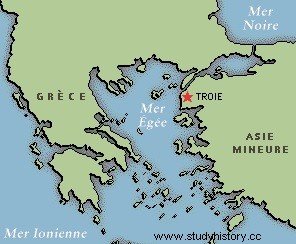 Troy (or Ilion) is an ancient city of Asia Minor, located on the current site of Hisarlik on the Aegean coast, in the northwest of Turkey. The foundations of the site of Troy were located by Heinrich Schliemann in the 1870s. Since that date, the excavations undertaken have made it possible to determine nine successive foundations of the city, from the 3rd millennium to Roman times. This site was recognized by UNESCO in 1998 as being that of the city of Troy . According to archaeologists, the city was destroyed by fire at the beginning of the 12th century BC. J.-C, perhaps following a conflict with the Greeks...
Troy (or Ilion) is an ancient city of Asia Minor, located on the current site of Hisarlik on the Aegean coast, in the northwest of Turkey. The foundations of the site of Troy were located by Heinrich Schliemann in the 1870s. Since that date, the excavations undertaken have made it possible to determine nine successive foundations of the city, from the 3rd millennium to Roman times. This site was recognized by UNESCO in 1998 as being that of the city of Troy . According to archaeologists, the city was destroyed by fire at the beginning of the 12th century BC. J.-C, perhaps following a conflict with the Greeks...
The Myth of the Trojan War
In the eighth century BC. J.C., Homer told the story of the Trojan War , which, according to various ancient authors, takes place between 1344 and 1150 BC. According to this account, the conflict begins when Venus promises Paris, son of Priam, the king of Troy, the love of the most beautiful of women, Helen. Later, in Sparta, Paris is invited to stay with King Melenas, husband of the beautiful Helen of Troy. He falls in love with the latter, kidnaps her (or she follows him voluntarily depending on the version), and brings her back to his home in Troy. Menelaus then organizes an expedition to bring back his wife, but also to avenge his honor, because Paris has flouted the rules of hospitality. He forms an army, led by his brother Agamemnon, king of Argos.
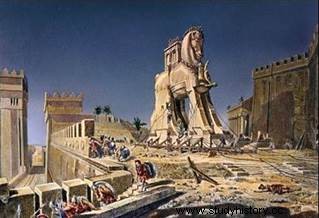 The Greek warriors besieged the city of Troy for ten years, after which they finally defeated it, entering hidden inside the famous Trojan horse, which the Trojans take for an offering intended for the goddess Athena. The city is then set on fire and destroyed.
The Greek warriors besieged the city of Troy for ten years, after which they finally defeated it, entering hidden inside the famous Trojan horse, which the Trojans take for an offering intended for the goddess Athena. The city is then set on fire and destroyed.
In the Homeric story, the Iliad, opens with the account of the wrath of Achilles, Greek hero (son of a mortal and a goddess). The Trojan War began almost nine years ago, and Agamemnon has just seized a captive, Briseis, whom Achilles coveted. This one, furious, withdraws under his tent and refuses to resume the fight. It was not until the death of Patroclus, his dearest friend, killed by the Trojan Hector, that he took up arms again to avenge him.
The Iliad thus ends with the death of Hector and the grandiose funeral celebrated for Patroclus by his friend. The story is organized in a series of tables describing scenes of war. It is only in the Odyssey, the story of the long and difficult return of Odysseus, king of Ithaca, to his homeland, that we know a little more about the first nine years of the war, and especially on the end of the conflict and the famous episode of the Trojan horse.
The Greek historians of the 5th century BC (Herodotus, author of the Histories, and Thucydides, to whom we owe the Peloponnesian War) provide explanations for the Homeric tradition historical and political. for the first the Trojans represent the eternal enemies of Greece:the Persians. The Trojan War would therefore be, according to the “father of history”, a first Persian war.
Thucydides' analysis is more political. For him the conflict described by Homer symbolizes the first attempt to bring the Greeks together with a view to conquest, a first form of Hellenic imperialism in a way. The veracity of the poems is therefore not questioned by the Ancients:the events they describe have in their eyes a historical reality.
Schliemann and the discovery of the archaeological site of the city of Troy
Passionate about the Iliad since childhood, in his late forties, this wealthy merchant abandons his wife and children, and dedicates the rest of his life to finding the site of Troy. First considered a sweet dreamer in the eyes of the scientific community, his stubbornness eventually paid off. The apprentice-archaeologist is based on a method that is surprising to say the least:relying on his perfect knowledge of Homer's text, Heinrich Schliemann applies himself to finding the site which would resemble these descriptions in every way.
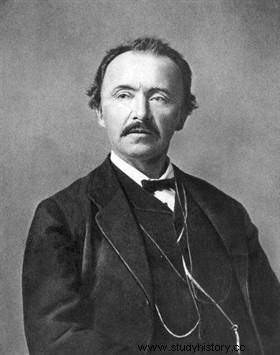 His meeting with Frank Calvet, who bought part of Hisarlik hill, will be decisive in his location of Troy. The topographic features of the site match Homer's descriptions. The place is already suspected to be that of Troy, and scholars have already taken an interest in it:Charles MacLaren, Gustav von Eckenbrecher, and Calvet himself began excavations there, aborted for lack of financial means. The real excavations will be carried out by Schliemann in 1870.
His meeting with Frank Calvet, who bought part of Hisarlik hill, will be decisive in his location of Troy. The topographic features of the site match Homer's descriptions. The place is already suspected to be that of Troy, and scholars have already taken an interest in it:Charles MacLaren, Gustav von Eckenbrecher, and Calvet himself began excavations there, aborted for lack of financial means. The real excavations will be carried out by Schliemann in 1870.
They begin with the digging of a gigantic trench to observe the stratigraphy. At the time, archeology was not yet a rigorous science, and this discipline was still largely imbued with amateurism, especially since Schliemann had only recently graduated in archeology. He does not raise the levels that he thinks postdate the Homeric Troy site, and some information is lost forever.
However, with regard to the level that Schliemann thinks is that of the mythical city (Troy II, penultimate oldest level), gradually appears the establishment of a protocol:study of the stratigraphy, systematic photography, keeping a diary... And the progress of the excavations is presented to a panel of experts, with the aim of advancing research, an innovative method in archaeology.
 Schliemann discovers traces of fire, and a citadel he thinks is that of King Priam. He also makes a spectacular discovery, hastily called "Priam's treasure":a set of precious gold and silver jewelry, hidden in a silver vase, including two tiaras, a headband, six bracelets and two goblets, all in gold, around sixty gold earrings as well, and more than 8,000 rings, prisms and buttons. He photographs Sophia, his young Greek wife, adorned with jewels. The treasure also contains vases, cups and cauldrons in gold, silver and bronze, as well as spearheads and copper axes.
Schliemann discovers traces of fire, and a citadel he thinks is that of King Priam. He also makes a spectacular discovery, hastily called "Priam's treasure":a set of precious gold and silver jewelry, hidden in a silver vase, including two tiaras, a headband, six bracelets and two goblets, all in gold, around sixty gold earrings as well, and more than 8,000 rings, prisms and buttons. He photographs Sophia, his young Greek wife, adorned with jewels. The treasure also contains vases, cups and cauldrons in gold, silver and bronze, as well as spearheads and copper axes.
The scientific community is skeptical about the authenticity of the site, because several elements do not agree with what we know of Troy. First of all the size of the city, indeed Troy is described as a large capital, but the site could only identify a population of 300 inhabitants, which could hardly have faced a 10-year siege. Moreover, the city is located 7 km from the sea, so the Greeks could not land in the immediate vicinity, as Homer tells it. Finally, if a few arrowheads have been found, they are quite sporadic, and there are no traces of destruction or skeletons of warriors.
Manfred Korfmann's Research
Other archaeologists follow one another on the site:Wilhelm Dörpfeld (collaborator of Schliemann) Carl Blegen, John Manuel Cook. Emil Forrer, specialist in the ancient Near East, already puts forward a possible connection with the Hittites.
In 1988, Manfred Korfmann began his research, his interest was purely scientific, he did not believe in the existence of the Homeric Troy, and was interested in the Greek and Roman periods , most recent. According to him, the importance of the site is not its possible assimilation to Troy, but its location at the entrance to the Dardanelles strait, which connects the Mediterranean to the Sea of Marmara and the Black Sea, a situation which probably made it an important hub of trade between Asia Minor and southeastern Europe.
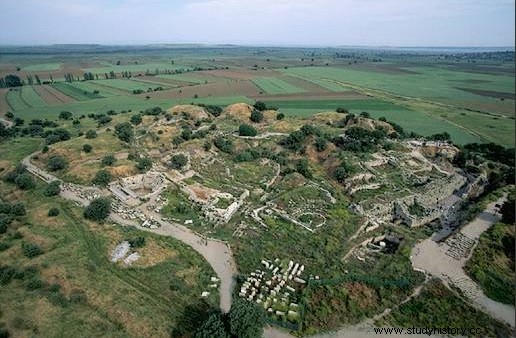 The various excavation campaigns reveal 9 levels of occupation, over a period of approximately 5000 years. The first occupation of the city dates back to the Bronze Age (4000 BC), and the site was occupied until the end of Roman times (4th century). On the level of Roman occupation, Korfmann discovers the traces of a pilgrimage:the city is already recognized as being that of Troy at the time. This is what drives the archaeologist to research Troy.
The various excavation campaigns reveal 9 levels of occupation, over a period of approximately 5000 years. The first occupation of the city dates back to the Bronze Age (4000 BC), and the site was occupied until the end of Roman times (4th century). On the level of Roman occupation, Korfmann discovers the traces of a pilgrimage:the city is already recognized as being that of Troy at the time. This is what drives the archaeologist to research Troy.
At the very beginning of the 2000s, he studied the Trojan level VII (c. 1300-1190 BC). By examining the door of the "enclosure", he realizes that the latter has no defensive function, so it is not the city wall. Magnetic resonance surveys have revealed a lower town, and the grip of the agglomeration is in fact 15 times larger. The site of Troy discovered by Schliemann is only the tip of the iceberg, a kind of fortified acropolis dominating the city. Enclosing the lower town, a real enclosure is discovered, consisting of a so-called "cyclopean" wall.
Concerning the location of the sea, which does not agree with Homer's Troy, Korfmann then had the idea of carrying out soundings on the outskirts of the city, and little deep down marine sediments appear, dated to around 3000 BC. J.C.. The sea was then, at the time, at the gates of the city.
In the 2000s, traces of a fire are identified, which could correspond to the destruction of Troy by the Greeks described by Homer. Finally, Korfmann's latest research highlights skeletons and slingshot bullets. With the new dating of the different strata, the level excavated by Schliemman cannot correspond to the level of the Homeric Troy, since it is more than 1000 years prior to its presumed existence, and the discovered treasure cannot be that of Priam.
Troy, a coveted strategic city
However, Korfmann strives to find an explanation other than that of the Trojan myth. This site therefore presents a large agglomeration with traces of battle around 1250 BC. J.C., the possible era of the Trojan War. But it is also the time of the new Hittite empire, whose exchanges with Anatolia are known. Witness the biconvex metal seal, discovered on the site, engraved with Luvite hieroglyphs, a language assimilated to the Hittites. Following the discovery of the seal, Korfmann came into contact with David Hawkins, a specialist in the dead languages of Asia Minor, who was studying a Hittite tablet.
The latter is translated as a treaty of peace and commerce between the Hittites and an important city in northwestern Turkey. Is it Troy? Other Hittite tablets mention the town of Wilusa (Wilios in Greek, which would correspond to Ilios, another name for Troy), a vassal town of the Hittites, and by cross-checking the various information on Wilusa, it can be located in Hisarlik. A conflict, or several (because other traces of fire and battle can be located in other strata), may have taken place between the Hittites and the Mycenaeans at the site, disputing the strategic position it represented .
Current research on the Hisarlik site
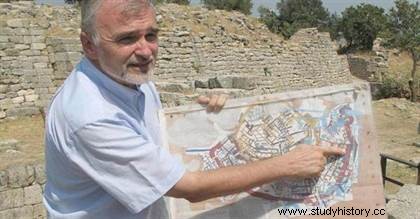 Since Korfmann died in 2005, it is Ernst Pernicka who took over, focusing on the anthropological aspect. At level VIIa, he unearthed a number of human remains, and skeletons of riders buried with their horses. The remains showed signs of violent death, further supporting the idea that a deadly conflict took place at the site during the Trojan era described by Homer. In addition, his analyzes highlight a fire, and much larger than that discovered by Korfmann. A carbon-14 coal analysis dates the fire to around 1225.
Since Korfmann died in 2005, it is Ernst Pernicka who took over, focusing on the anthropological aspect. At level VIIa, he unearthed a number of human remains, and skeletons of riders buried with their horses. The remains showed signs of violent death, further supporting the idea that a deadly conflict took place at the site during the Trojan era described by Homer. In addition, his analyzes highlight a fire, and much larger than that discovered by Korfmann. A carbon-14 coal analysis dates the fire to around 1225.
The geographical location of Hisarlik corresponds to that of Troy in Homer's account, and a great conflict is attested at the site in the 13th century BC. J.C., or in the period where the ancient authors place the Trojan war. This site was very probably a strategic point at that time, since it controlled a passage between the Mediterranean and the Black Sea, between East and West, profitable to trade, to exchanges, and its domination probably gave rise to conflicts. The hypothesis of a great war between Hittites and Mycenaeans for the control of Troy is possible, and this event could have inspired the legend of the Trojan War.
Bibliography
- The Gold of Troy or Schliemann's Dream, by Hervé Duchêne. Gallimard, 1995.
- The Fabulous Discovery of the Ruins of Troy:First Journey to Troy (1871) followed by Trojan Antiquities (1871-1873), by Heinrich Schliemann. Text, 2011.
To go further
- The reality of Troy (BNF site)
- Archaeological site of Troy (Unesco)
